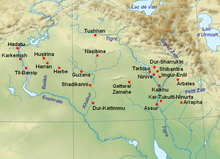Tell Chuera
Harbe | |
| Location | Raqqa Governorate, Syria |
|---|---|
| Region | Northern Mesopotamia |
| Coordinates | 36°38′44.88″N 39°29′53.88″E / 36.6458000°N 39.4983000°E |
| Type | tell |
| Site notes | |
| Excavation dates | 1958–1960s 1973–1977 1982-present |
| Archaeologists | A. Moortgat, U. Moortgat-Correns, W. Orthmann, J.-W. Meyer |
Tell Chuera (also Tell Ḫuera and Tall Ḥuwaira and Tall Chuera and Tell Khuera) is an
Site details
The site of Tell Chuera is roughly 1 kilometre (0.62 mi) in diameter and 18 metres (59 ft) high.
History

Tell Chuera was settled in the Early Bronze (3rd millennium BC), and again in the Late Bronze (Late 2nd millennium BC).[1]
Early Bronze
Originally occupied during the 4th millennium, Tell Chuera became a major site in the 3rd millennium during the
In the Early Bronze IVB, the site was active during the
Late Bronze
A small settlement was built on the location by the Mittani during the middle 2nd millennium BC followed by the Assyrians. Equid bones from that period have been identified as horses.[3] During Middle Assyrian times it was known as Harbe.[4] It has been proposed that in earlier times its name was Abarsal[5]
Excavation history
The site was first described by
See also
- Cities of the ancient Near East
- Tell Beydar
- Tell Brak
- Tell Khoshi
References
- ^ Meyer 2021
- ^ Schwartz, Glenn M., "The Ninevite V Period and Current Research", Paléorient, vol. 11, no. 1, pp. 53–70, 1985
- ^ Vila, Emmanuelle, "Les vestiges de chevaux à Tell Chuera. Premières datations", Kulturlandschaft Syrien. Zentrum und Peripherie. Festschrift für Jan-Waalke Meyer, hrsg. v. Jörg Becker, Ralph Hempelmann, Ellen Rehm (Alter Orient und Altes Testament 371), pp. 607-622, 2010
- ^ Pfeifer, Guido, "Stefan Jakob, Die mittelassyrischen Texte aus Tell Chuēra in Nordost-Syrien mit einem Beitrag von Daniela I. Janisch-Jakob", Zeitschrift der Savigny-Stiftung für Rechtsgeschichte. Romanistische Abteilung, vol. 131, no. 1, pp. 552-553, 2014
- ^ Archi, Alfonso. "The Wars of Ebla at the Time of Minister Ibrium" Altorientalische Forschungen, vol. 48, no. 2, 2021, pp. 189-220
- ^ Anton Moortgat, Tell Chuera in Nordost-Syrien. Vorläufiger Bericht über die Grabung 1958, Köln und Opladen, 1960
- ^ Anton Moortgat, Tell Chuera in Nordost-Syrien. Vorläufiger Bericht über die zweite Grabungskampagne 1959, Wiesbaden, 1960
- ^ Anton Moortgat, Tell Chuera in Nordost-Syrien. Vorläufiger Bericht über die dritte Grabungskampagne 1960, Köln und Opladen, 1962
- ^ Anton Moortgat, Tell Chuera in Nordost-Syrien. Bericht über die vierte Grabungskampagne 1963, Köln und Opladen, 1965
- ^ Anton Moortgat, Tell Chuera in Nordost-Syrien. Vorläufiger Bericht über die fünfte Grabungskampagne 1964, Köln und Opladen, 1967
- ^ Anton Moortgat and Ursula Moortgat-Correns, Tell Chuera in Nordost-Syrien. Vorläufiger Bericht über die sechste Grabungskampagne 1973, Gebrüder Mann Verlag, 1975
- ^ Anton Moortgat and Ursula Moortgat-Correns, Tell Chuera in Nordost-Syrien. Vorläufiger Bericht über die siebte Grabungskampagne 1974, Gebrüder Mann Verlag, 1976
- ISBN 3-7861-1198-7
- ^ Mallowan, M. E. L., "Tell Chuēra in Nordost-Syrien", Iraq, vol. 28, no. 1, pp. 89–95, 1966
- ISBN 3-7861-1451-X
- ^ Ursula Moortgat-Correns, "Tell Chuera in Nordost-Syrien. Vorläufiger Bericht über die elfte Grabungskampagne 1985", Berlin, 1988
- ISBN 3-925036-92-X
- ISBN 978-3-447-06182-7
Further reading
- Joachim Bretschneider, Jan Driessen and Karel van Lerberghe, Power and architecture: monumental public architecture in the Bronze Age, David Brown, 2007, ISBN 90-429-1831-4
- Dibo, Suzanne, "L’architecture Monumentale De Tell Chuera: Des Temples Ou Des Bâtiments Administratifs ?", Syria, vol. 93, pp. 235–54, 2016
- Hartmut Kühne, "Die Keramik vom Tell Chuera und ihre Beziehungen zu Funden aus Syrien-Palästina, der Türkei und dem Iraq", Berlin, 1976
- Hrouda, B., "Bericht Über Die Ausgrabung (Tell Chuera)", Revue d’Assyriologie et d’archéologie Orientale, vol. 58, no. 4, pp. 183–84, 1964
- Stefan Jakob, "Die mittelassyrischen Texte aus Tell Chuera in Nordost-Syrien", Harrassowitz Verlag, 2009, ISBN 3-447-05724-6
- Krasnik, Klaus, and Jan-Waalke Meyer, "Im Tod Den Göttern Nahe: Eine Prunkvolle Bestattung in Tell Chuera, Nordsyrien", Antike Welt, vol. 32, no. 4, pp. 383–90, 2001
- Jan-Waalke Meyer, "Ausgrabungen in Tell Chuera in Nordost-Syrien Band 2: II: Vorbericht zu den Grabungskampagnen 1998 bis 2005", Harrassowitz Verlag, 2010, ISBN 978-3-447-06182-7
- Moortgat-Correns, Ursula, "'Tell Chuēra.' Archiv Für Orientforschung", vol. 35, pp. 153–63, 1988
- Moortgat-Correns, Ursula, "Der Tell Chuēra im Rückblick (1958-1985)", Altorientalische Forschungen, vol. 28, no. 2, pp. 353-388, 2001
- Ursula Moortgat-Correns, "Tell Chuera in Nordost-Syrien. Vorläufiger Bericht über die neunte und zehnte Grabungskampagne 1982 und 1983", Berlin, 1988
- Winfried Orthmann, "Tell Chuera. Ausgrabungen der Max Freiherr von Oppenheim-Stiftung in Nordost-Syrien", Damaskus und Tartous, 1990
- Winfried Orthmann, "L'architecture religieuse de Tell Chuera", Akkadica, vol. 69, pp. 1–18, 1990
- W. Orthmann, "The Origins of Tell Chuera," in The Origins of Cities in Dry Farming Syria and Mesopotamia in the Third Millennium B.C., ed. H. Weiss (Guilford, Conn.: Four Quarters Publishing, 1986)
- Quenet, Philippe, "Un sceau-cylindre inédit de Tell Khuera (Syrie du Nord) et sa place au sein de la glyptique géométrique du Bronze ancien en Mésopo-tamie", Revue d'assyriologie et d'archéologie orientale, 101, p. 3-34, 2007
- Michael Zick: "Tell Chuera – Stadtplanung vor 5000 Jahren". in: "Bild der Wissenschaft." Leinefelden-Echterdingen 1/2005,1, S. 72–76. ISSN 0006-2375

